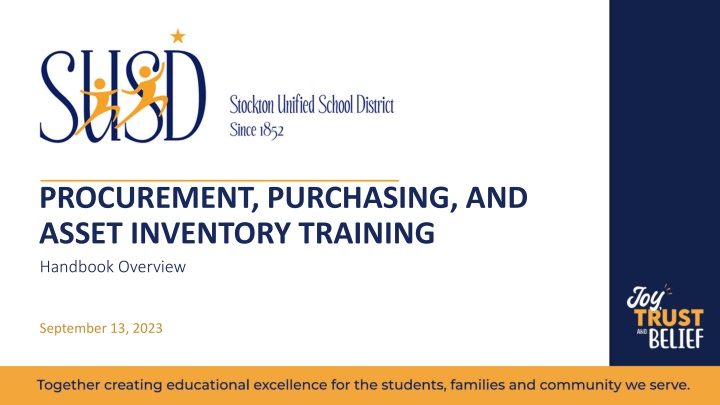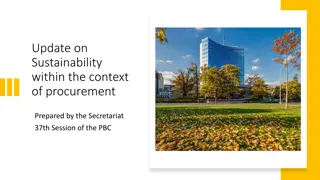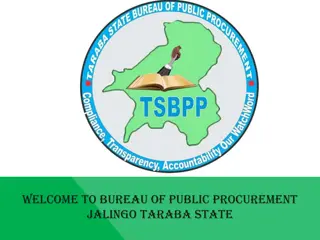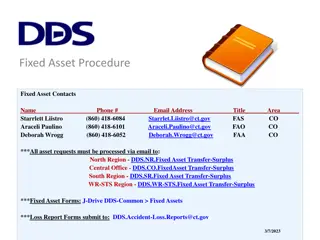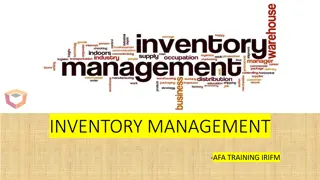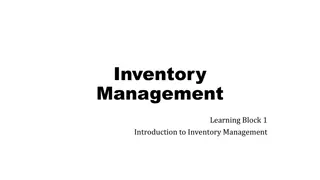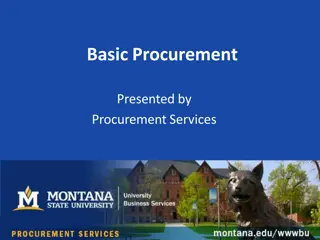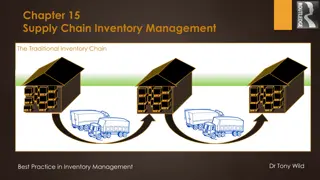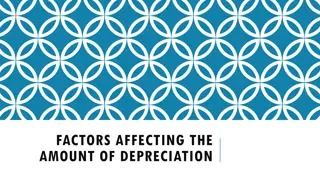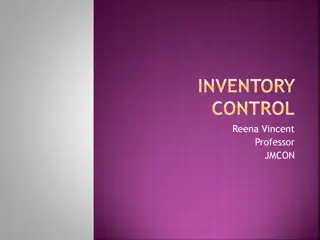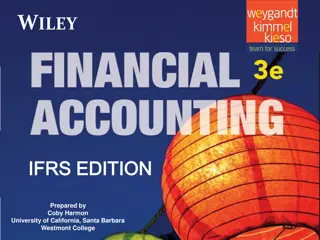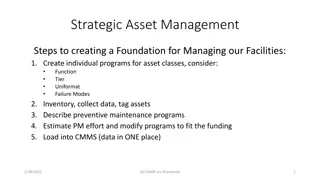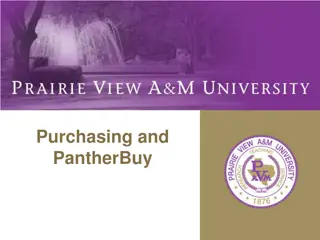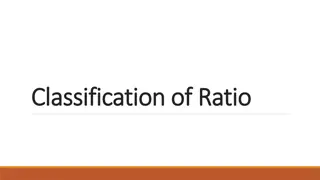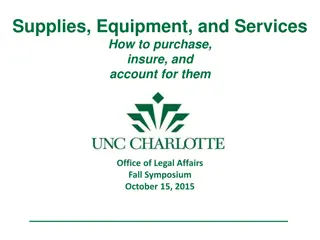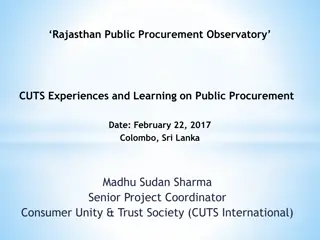Comprehensive Guide to Procurement, Purchasing, and Asset Inventory Training
Explore the essential concepts of procurement and purchasing, including the differences between them, public bidding requirements, confidentiality in bids, quotations, and proposals. Learn about asset inventory management and surplus disposal processes to enhance your organization's efficiency and compliance with state and federal regulations.
Download Presentation

Please find below an Image/Link to download the presentation.
The content on the website is provided AS IS for your information and personal use only. It may not be sold, licensed, or shared on other websites without obtaining consent from the author.If you encounter any issues during the download, it is possible that the publisher has removed the file from their server.
You are allowed to download the files provided on this website for personal or commercial use, subject to the condition that they are used lawfully. All files are the property of their respective owners.
The content on the website is provided AS IS for your information and personal use only. It may not be sold, licensed, or shared on other websites without obtaining consent from the author.
E N D
Presentation Transcript
PROCUREMENT, PURCHASING, AND ASSET INVENTORY TRAINING Handbook Overview September 13, 2023
AGENDA Procurement vs. Purchasing Bids, Quotations, & Proposals State and Federal Thresholds Federal Procurement Process Asset Inventory Surplus & Disposal Process
PROCUREMENT VS. PURCHASING Procurement: A term encompassing all elements of the district s purchasing process The elements typically include the following: Determining procurement needs Developing a procurement strategy Identifying potential suppliers Negotiating the best price Approving purchase requests Maintaining procurement documentation Purchasing goods/services Adhering to federal, state, and local laws. Procurement allows for the district to demonstrate accountability and good stewardship of the public funds received for goods and services to meet the needs of our students.
PROCUREMENT VS. PURCHASING Purchasing: The act of buying goods and services needed to operate and conduct business. The purchasing process typically includes these activities : Submitting purchase requisitions Submitting purchase orders to vendors Receiving invoices Confirming receipt/delivery of goods or services Payment of invoice Purchasing is a transactional component of the overall procurement process.
ELEMENTS OF A PUBLIC BID A formal bid by a public school district contains several necessary elements. These include: legal advertisement, standard specifications, set bid due date and time, and responsive and responsible bidders. These basic elements are required to ensure a level playing field for all bidders. In addition, to the requirements above, a formal bid takes time. Most school districts find that the bidding process takes a minimum of three to four weeks, and typically requires Board approval for permission to go out to bid, and acceptance of the recommended bidder.
BIDS, QUOTATIONS, & PROPOSALS Confidentiality: In accordance with fair and sound business practices, all information supplied by vendors in their bid, quotation or proposal must be presented under sealed cover and held in strict confidence. Bids may not be revealed to any other vendor or unauthorized individual while the procurement process is taking place. Once the procurement process has completed, all records are considered public information and must be made available for public review.
BIDS, QUOTATIONS, & PROPOSALS Errors: Vendors are responsible for the accuracy of their quoted prices. Quotations may be amended or withdrawn by the bidder up to the bid opening date and time, after which, in the event of an error, bids may not be amended, but maybe withdrawn prior to the acceptance of the bid. After an order has been issued, no bid may be withdrawn or amended unless the Purchasing Department considers the change to be in the District s best interest. All changes must be in writing with mutual agreement.
BIDS, QUOTATIONS, & PROPOSALS Late Quotations & Rejection of Bids: It is the responsibility of all vendors to ensure that their quotations are received in the Purchasing Department no later than the appointed hour of the bid opening date. Late quotations will not be considered and will not be opened. The District reserves the right to reject all bids, quotations and/or proposals and re- solicit or cancel the procurement if deemed by the District to be in its best interest.
WHEN IS BOARD PRE-APPROVAL REQUIRED? All contracts with new vendors between $10,000 - $50,000. All contracts with existing vendors in excess of $50,000.
STATE AND FEDERAL THRESHOLDS Federal and State Procurement Requirements Federal Requirements 2 CFR 200.320 Micro-purchases may be awarded without soliciting competitive price or rate quotations if SUSD considers the price to be reasonable based on research, experience, purchase history or other information and documents it files accordingly. State Requirements Public Contract Code (PCC) Section 20111(a) N/A Micro-purchases: total cost is under $10,000 Small purchase: total cost is $10,001 - $109,300 For small purchases, price or rate quotations must be obtained from an adequate number of qualified sources. N/A Formal procurement: sealed bids or proposals Used for purchases that exceed small purchase threshold over $109,300. Public Contract Code (PCC) requires school district governing boards to competitively bid and award any contracts involving an expenditure of more than $50,000*, adjusted for inflation, to the lowest responsible bidder. Contracts subject to bidding include: Purchase of equipment, materials, or supplies to be furnished, sold, or leased to the school district, services that are not construction services. Repairs, including maintenance as defined in PCC Section 20115, that are not public projects as defined in PCC Section 22002(c). * For calendar year 2023 the bid threshold has been adjusted to $109,300. Formal procurement: sealed bids or proposals Used for purchases that exceed purchase threshold over $250,000. The independent cost price analysis may consist of, but is not limited to, market research, a general survey of prices for similar goods or services, a comparison to similar purchases previously made, or an internal system for developing a price range for the specific purchase.
FEDERAL PROCUREMENT PROCESS Methods of Procurement: Micropurchase Micropurchases may be awarded without soliciting competitive quotations or comparing prices among qualified suppliers if the two conditions are met: The aggregate value of single transaction is $10,000 or less. SUSD staff considers the price to be reasonable. Documentation (e.g. receipts and invoices) must be maintained for the prior three years plus the current Program Year (PY), or until the next Federal Pass-through Agency (FPA) review, to document costs that are reasonable. SUSD will use various qualified suppliers to the extent practical. Micropurchases are used for goods and services that are needed on an emergency basis or for items needed occasionally (e.g. gluten-free products). It is not intended to be used to avoid a small/informal or formal procurement.
FEDERAL PROCUREMENT PROCESS Methods of Procurement: Small Purchase Used to procure goods and services when the aggregate cost is $10,000 - $109,300. Price or rate quotations will be obtained from a minimum of two responsible and responsive sources. Price quotes must be documented in writing per SUSD policy. Price quotes provided verbally by a vendor must be documented in writing. SUSD Purchasing Manager, or designee, will evaluate the written quotes received. SUSD Purchasing Manager, or designee, will award small purchases to the lowest priced responsible and responsive vendor. SUSD Purchasing Manager, or designee, will monitor the contract
FEDERAL PROCUREMENT PROCESS Methods of Procurement: Formal Purchase Used to procure goods and services when the estimated total cost threshold is $109,300 or above. (Federal total cost threshold is $250,000, but SUSD must adhere to the more stringent State total cost threshold of $109,300). Both Invitation for Bid (IFB) and Request for Proposal (RFP) methods are used by SUSD The terms of formal contracts will be one year with two one-year renewal options. The covered period must coincide with District s fiscal year when using federal funds.
FEDERAL PROCUREMENT PROCESS Methods of Procurement: Formal Purchase continued SUSD will follow the following steps when conducting formal procurements: SUSD Purchasing Manager, or designee, will develop a written solicitation. The solicitation will incorporate: A clear and accurate description of the technical requirements for the goods or services to be procured per 2 CFR, Section 200.319(d) (1) The requirement to comply with the Buy American Provision per 7 CFR, sections 210.21(d) and 220.16(d) All requirements that the offers must fulfill and all other factors (IFBs and RFPs) and their relative importance (RFPs only) used in evaluating bids or proposals per 2 CFR, Section 200.319(d) (2) to judge responsive and responsible firms Instructions for responding vendors The general terms and conditions of the contract SUSD Purchasing Manager, or designee, will advertise the solicitation in the print and on web site a minimum of two weeks prior to the deadline for submission of bids and proposals.
FEDERAL PROCUREMENT PROCESS Methods of Procurement: Formal Purchase continued SUSD Purchasing Department will publicly open bids resulting from IFBs at the time and place prescribed in the solicitation. SUSD will not publicly open proposals resulting from RFPs. SUSD Program Administrator, or designee, and purchasing manager will evaluate offers from responding firms by using the evaluation criteria outlined in the solicitation for both IFBs and RFPs. SUSD should receive at least two bids or proposals to evaluate the offers. If there is not a minimum of two respondents, SUSD will review the solicitation to ensure that it is not limiting competition as outlined in 2 CFR, Section 200.319, and consider expanding advertising efforts before reissuing the solicitation. The offers will be ranked based on cost only for IFBs and on evaluation criteria (i.e. technical criteria) and cost for RFPs for all responsible and responsive responders. SUSD will document all evaluation of RFPs in writing for RFPs only. SUSD purchasing manager will negotiate the technical aspects of each RFP prior to negotiating the cost aspect of the RFP. Any or all bids may be rejected if there is sound documented reason. SUSD will award the contract to the responsible and responsive bidder who offers the lowest price for IFBs. All IFBs will result in a firm, fixed price contract. SUSD Program Administrator, or designee, will monitor contract
FEDERAL PROCUREMENT PROCESS Methods of Procurement: Noncompetitive SUSD will only enter into a noncompetitive agreement when one or more of the following circumstances apply: The item is available only from a single source An emergency exists, and the urgency for the requirement will not permit the delay resulting from competitive solicitation After solicitation from a number of sources, competition is determined inadequate SUSD received prior approval from the FPA after submitting a written request to the FPA with justification for conducting a noncompetitive procurement SUSD will use this method when all awarding noncompetitive procurement contacts
FEDERAL PROCUREMENT PROCESS Methods of Procurement: Single Source Noncompetitive A single source is source specifically selected amongst others, if any, due to specific reasons, i.e. replacement parts, compatibility, quality, service, support, etc. In cases where it is determined that only a single vendor will properly meet the needs of the District, competition can be considered exempt. SUSD will only enter into a noncompetitive agreement with approval from the FPA.
FEDERAL PROCUREMENT PROCESS Methods of Procurement: Sole Source Noncompetitive Specific products or services available from only one source, also called sole source, sole provider, sole supplier, sole vendor, or sole distributor. A sole source evaluation will take place, but in a significantly different manner because no comparison to be performed against other prospective providers. Sole source procurement is only used when other procurement methods, namely informal bidding and competitive solicitation, are not applicable or lead to an unrealistic processing time.
FEDERAL PROCUREMENT PROCESS Methods of Procurement: Purchasing Cooperatives and Intergovernmental If applicable, SUSD may choose to make purchases through a cooperative agreement with a group of other schools to increase purchasing power of SUSD may piggyback on contracts awarded to a vendor from another school district when all procurement principles are followed. While intergovernmental agreements can benefit SUSD, SUSD may only enter into an intergovernmental agreement with a local government agency (e.g. school district) which allows other school to join or piggyback onto the local governmental entity when that agreement was procured and awarded consistent with federal and state procurement regulations.
ASSET INVENTORY Types of Assets: Capitalized Fixed Asset Defined as movable personal property, including such equipment as vehicles, machinery, computer systems, and playground equipment. Have both an estimated useful life over one year and an acquisition cost equal to or greater than the capitalization threshold of $5,000. Land and Improvements, and Buildings and Improvements, that exceed the capitalization threshold. Non-Capitalized Asset Defined as movable personal property of a relatively permanent nature Has an estimated useful life greater than one year and an acquisition cost less than the capitalization threshold but greater than the inventory threshold pursuant to Education Code Section 35168
ASSET INVENTORY Acquisition & Receiving: All assets will be purchased using the District s purchase order system within the financial software When the Purchasing Department receives a purchase request identified as an asset, the Ship To location will be changed to Property Control. When an item is deemed in the best interest to have the item shipped directly to the site, the Purchase Order will be flagged and a copy will be provided to Property Control. Property Control will tag the asset and record all pertinent information at the site after the item is received. Upon receipt of an asset(s), Property Control will inspect the order for accuracy against the purchase order, damage to order, and completeness of order. If any discrepancies or damage is noted, Property Control will contact Purchasing and make a report of the issues of the order. Purchasing will contact the vendor to rectify all issues and provide updates to Property Control and ordering site of issues and resolutions.
SURPLUS & DISPOSAL PROCESS Property Control will follow the following the steps: Transfer assets to PC Surplus Verify all assets included on Property Control Transfer Form are accounted for. Determine proper means of disposal Auction/Sale E-Waste Recycle Donation Asset is of working condition and has potential to be redeployed, store asset Notify Purchasing Manager of assets to be disposed and method of disposal Dispose asset & make asset as disposed in asset management software File all associated paperwork
RESOURCES The Procurement, Purchasing, and Asset Inventory Guide and this presentation can be found on the Purchasing Department s webpage at https://www.stocktonusd.net/Domain/155 Purchasing and Warehouse Contacts Purchasing Department: 209-933-7095 Warehouse: 209-933-7150 Central Receiving: 209-933-7150 ext. 2692 Property Control: 209-933-7150 ext. 2693 Department Email: purchasing@stocktonusd.net
